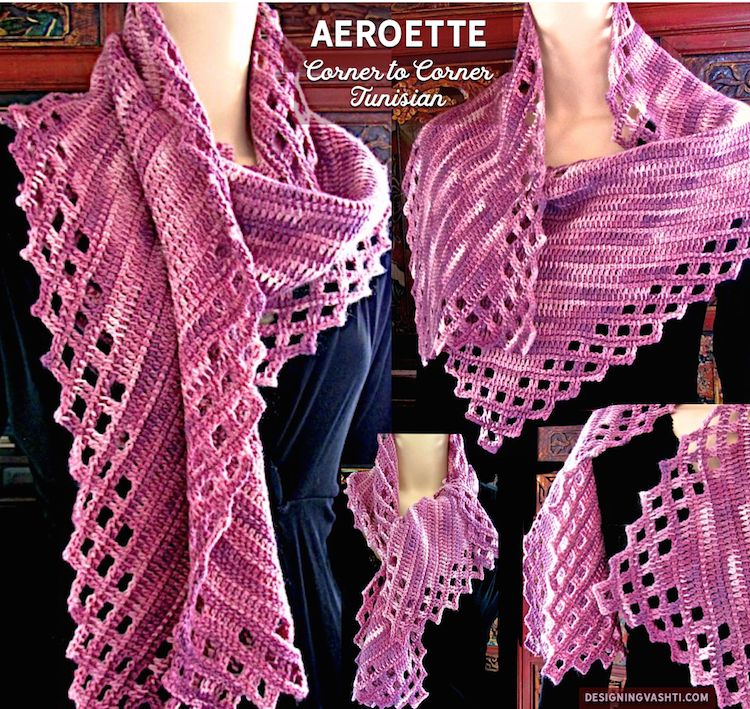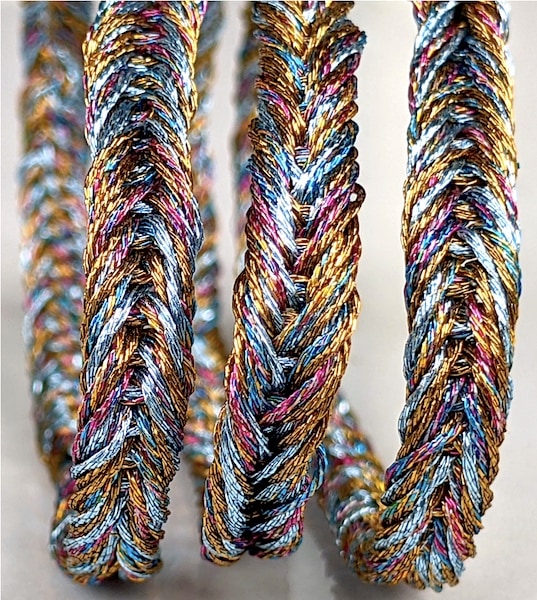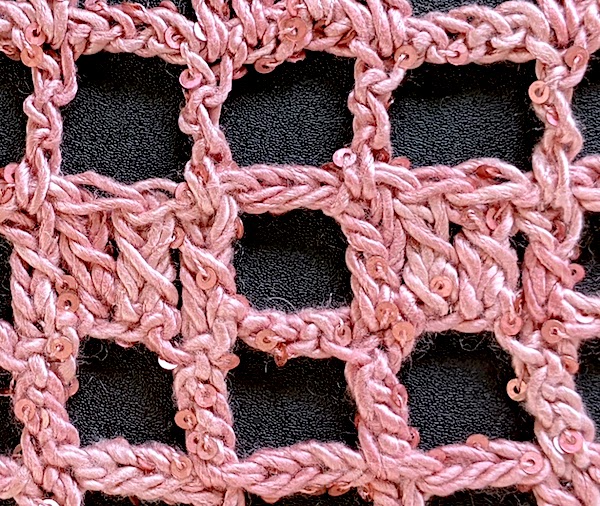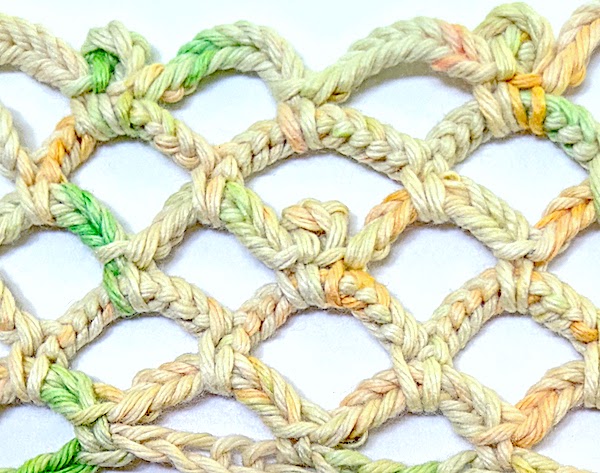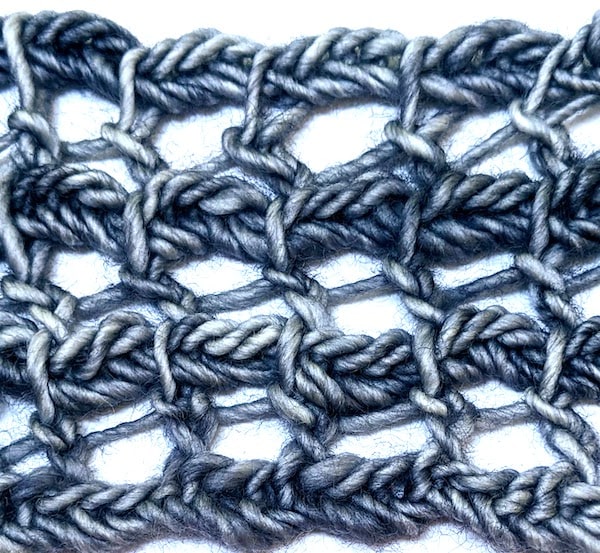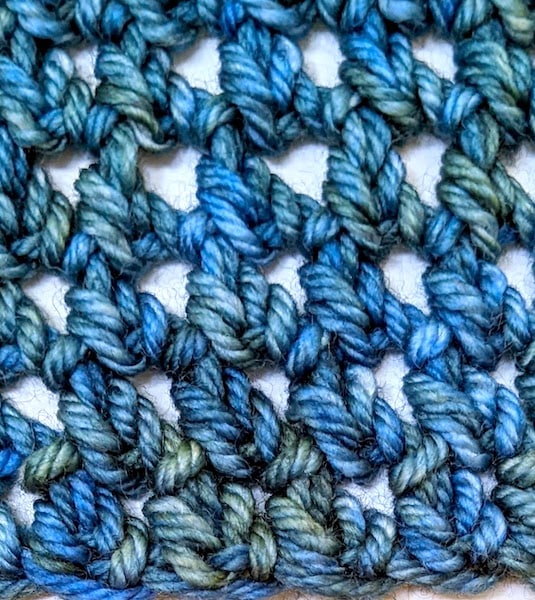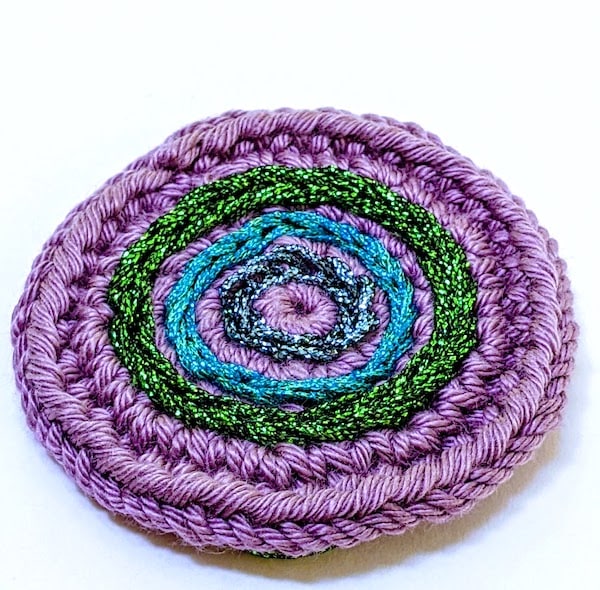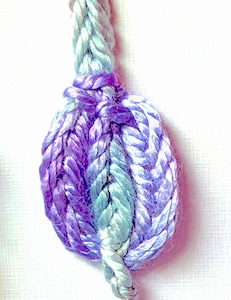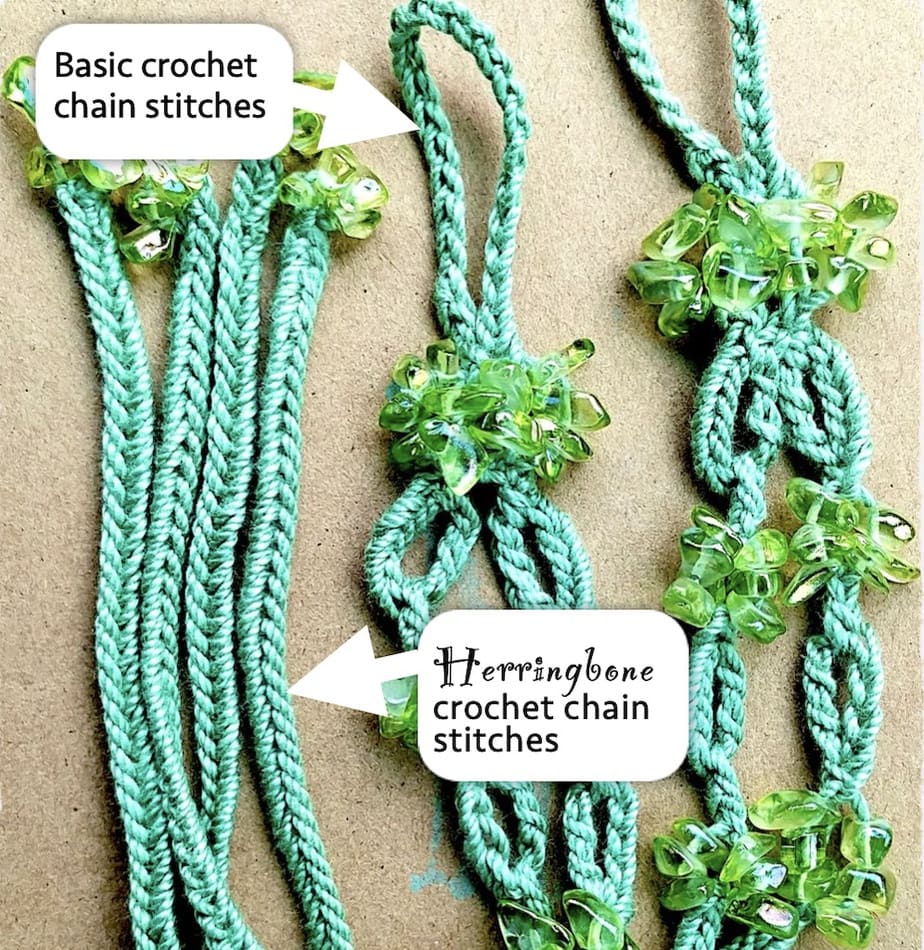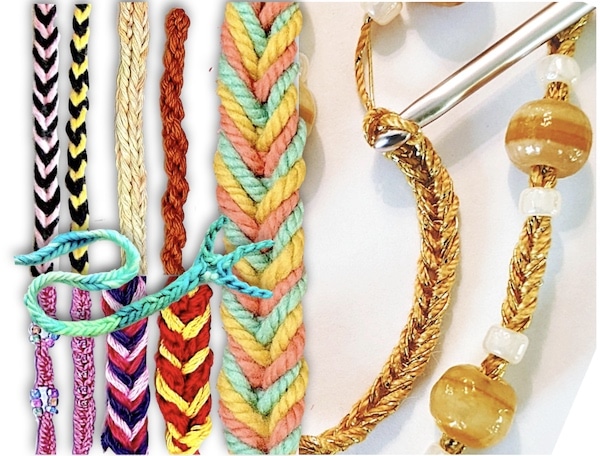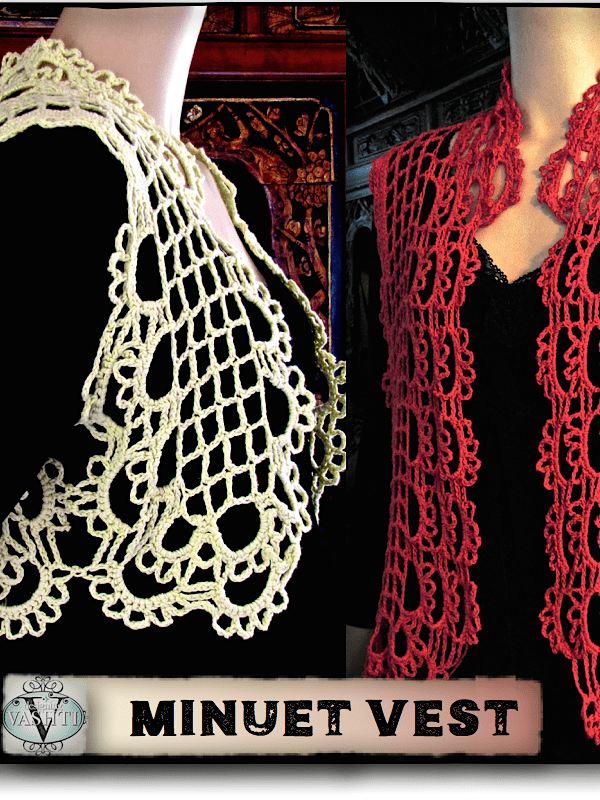
With just two skeins of a casual daytime cotton yarn, this summery vest can be thrown on over anything for a bold, modern lace statement. Use a polished fashion yarn, and the silky gloss suddenly takes the same design into an elegant Jane Austen-style world. The dramatic architecture of the lace is unforgettable over solid black.
The basic idea of the Minuet Vest is this: crochet a simple shape, add a fancy border, then link up the sides to turn it into a vest. I chose plain filet crochet lace for the simple base shape so that it would be quick to crochet. Filet is also an easy grid for edging with a fancy border later. Chains and single crochets are the only stitches needed for the lacy scallop border.
This design won the Hookalicious award in 2010 from the Crochet Liberation Front.
Pattern Features
This pattern explains step by step how to use a type of Tunisian Knit Treble stitch for the filet, like I used for the red Minuet. If you prefer to use regular crochet stitches such as the treble crochet + ch-2 filet I used for the cropped yellow version, see this online article about adjusting the gauge of filet stitches.
Printer-friendly filet charts and edging diagrams are on the last pages of this pattern.
Skill Level
Intermediate to Experienced because of the join-as-you-go seaming. Over the years I’ve encountered crocheters who struggle with assemble-as-you-go garment construction. The struggle may be with how it’s described in text, so I’ve created visual aids for this step on the last pages.
The skill level of the stitches is Intermediate due to the Tunisian crochet stitches used for the filet section. Experienced filet crocheters can substitute regular filet stitches following the filet charts on the last pages. The fancy scallop border requires only chains and single crochets.
I’ve kept pattern abbreviations to a minimum and include International English equivalents for American terms.
?After using this pattern you will know (if you didn’t already):
- How to construct a vest as you go, with a few crochet joins instead of seams.
- How to let a fancy border do all the shaping.
- How to use the same pattern to make a cropped bolero style.
- How to crochet an easy, great-looking Tunisian Filet stitch variation.
- How to adjust both stitch and row gauges of your filet crochet lace.
- How to fine-tune a standard size for a Petite or Tall fit.
Materials
- Crochet Hooks: Tunisian G-6 (4 mm) and approx. 10″ {25.4 cm} long; or size required for gauge. Regular crochet hook G-6 (4 mm) or size required for gauge.
- Ten stitch markers (for shoulders, corners, and side seam joins during final edging)
- Yarn: Choose a yarn in the #2 Fine Weight category with a recommended crochet hook size range of US E/4 {3.5 mm} to US G/6 {4.0 mm}. These yarns may also be referred to as Sport or Heavy Sock {Light DK, 5-Ply}. For example, Patons’ Grace (100% mercerized cotton; green swatch in photo album).
Yarn Used for Tunisian Cherry Vest: DesigningVashti.com Lotus (54% Cotton, 46% Rayon; 256yd/234m per 3.5oz/100g skein): 1 ball (256 yds) for cropped bolero lengths of all sizes except Medium and Large; 2 balls (512 yds) for most sizes in the longer Vest length shown; 2 balls plus 1 smaller Lotus Snacks ball (600 yds) for Size Large Vest (has 3rd layer of Scallop edging, shown).
Yarn Used for Key Lime Bolero: Universal Yarn’s Summer Linen (50% Linen, 50% Cotton, 126yd/115m per 1.76oz/50g ball): 2 balls (252 yds) used for Sizes Small and Smallish-Medium.
Finished Dimensions
How to choose your size: Make your vest any length you wish. This style is meant to be worn open and loose over other clothing, so even a close-fitting size will feel looser on (have more wearing ease) than it may seem from the measurements given below.
For this pattern, the most important measurement is the width from shoulder to shoulder. The next most important one for fit is the chest/bust circumference. Each size has more than one finished bust measurement listed. It’s based on how many scallop rounds you add to the border. For example, the red vest has three rounds of scallops at the front opening (with a fourth for the collar), whereas the cropped version has only one round of scallops (with a second for the collar). Each round of scallops adds almost 5″ {12.7 cm} to the total circumference.
Sizes Teen 14-16 and XSmall:
Across Shoulder when worn: 13″ {33 cm}
Finished Bust if vest is worn closed in front: 34″ {86.36 cm} with a border of two scallops would be a standard fit for a Size Teen 14-16, and close-fitting for an adult Size XSmall. 39″ {99 cm} with a wider border of three scallops would be a standard fit for an adult Size XSmall, and a very loose fit for a standard Teen.
Length: starts at 15″ {38 cm} for the cropped bolero style. Lengthen in 2.5″ {6.35 cm} increments easily with no limits; instructions are included in the pattern. Red vest shown is 22″ {55.88 cm} long. A knee length on a teen would look très Boho with boots and jeans!
Sizes Small and Smallish-Medium:
Across Shoulder when worn: 15″ {38 cm}
Finished Bust if vest is worn closed in front: 37″ {94 cm} with a border of two scallops would be a standard fit for a Size Small, and close-fitting for a Size Medium. 41.5″ {105.4 cm} with a wider border of three scallops would be a standard fit for a Size Medium, and loose-fitting for a Size Small.
Length: starts at 15″ {38 cm} for cropped bolero style. Red vest shown is 22″ {55.88 cm} long. Lengthen in 2.5″ {6.35 cm} increments easily with no limits; instructions in the pattern.
Sizes Largish-Medium and Large. For a Plus Size 1X option, see Note under Finished Bust, below.
Across Shoulder when worn: 17″ {43.18 cm}
Finished Bust if vest is worn closed in front: 39″ {99 cm} with a border of two scallops would be a standard fit for a Size Medium, and close-fitting for a Size Large. 44″ {111.76 cm} with a wider border of three scallops would be a standard fit for a Size Large, and loose-fitting for a Size Medium. Note: For a Plus Size 1X and 2X option, repeating the Scallop border a fourth time at only the sides would result in a finished bust of 49″ {126.46 cm}.
Length: starts at 17.5″ {44.45 cm} for the cropped bolero style. Red vest shown is 22″ {55.88 cm} long. Lengthen in 2.5″ {6.35 cm} increments easily with no limits; instructions in the pattern.
